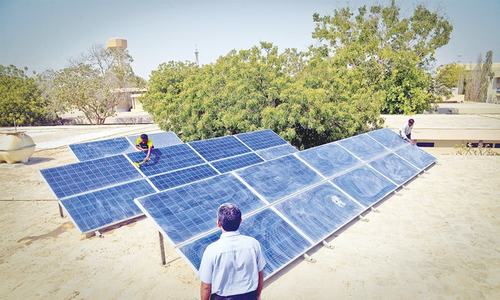
THE development of elaborate solar maps of Pakistan by the World Bank and the Alternate Energy Development Board is a step in the right direction. However, what is the likelihood of this making any significant impact on Pakistan’s solar and renewable energy landscape?
Solar energy has been making headlines across the world for the last few years. Between 2005 and 2010, the global installed capacity of solar photovoltaic (PV), also termed solar cells, has grown from 5GW to 227GW. Since 1977, the price of PV has dropped from $76/watt to $0.03/watt. This phenomenal success owes to wide-ranging factors; most importantly, conducive policies, technological advancements and economy of scale. Solar PV is now becoming financially competitive with conventional forms of power generation. Dubai, for example, is currently developing an 800MW PV project with a power purchase agreement signed at less than three US cents per kW hour.
Solar radiation, or level of sunshine, is the resource or fuel for solar energy systems. Accurate measurement and analysis of this resource are fundamental to achieving the anticipated performance. However, there are other important parameters that also need to be taken into account to predict and evaluate a system’s performance and this is often where mistakes are made.
The scope for solar energy in Pakistan is huge.
The layman’s perception is that hot climates are best for solar PV. Here we have two distinct but interrelated parameters — sunshine and temperature. These are two opposite factors when it comes to their impact on the performance of solar cells. The output from solar cells is directly proportional to the sunshine level, while it is adversely affected by temperature. It also heavily depends upon clarity of atmosphere. Factors like atmospheric dust, pollution, humidity and wind speed take a toll on the output. Careful selection of a site for solar systems, especially in the case of large-scale projects, is therefore critical; any lapses in evaluating the solar resource and other relevant climatic parameters can result in significant impact on a project’s viability.
While renewable energy is making an important contribution to the energy and environmental landscapes of many countries both in the developed and developing world, Pakistan has been extremely slow in capitalising on it. Even other South Asian countries have made tremendous progress in renewable energy.
For example, while India is amongst the leading countries in the world in terms of both solar and wind power, Bangladesh has over two million systems installed in the residential sector alone. At the small-scale level, there have been wide-ranging business models dealing with technologies like solar home systems, communal solar systems, biogas plants and improved cooking stoves. These accomplishments have been fostered by strong public- and private-sector patronage and institutional development.
In recent years, solar systems have found some acceptance in domestic and commercial sectors. Aside from the renewable energy policy development and tax exemptions on solar PV gear, there have been many public-sector initiatives, the most hyped being the Quaid-i-Azam Solar Park. However, their effectiveness especially in terms of business, levelised cost of electricity and sustainability is not clear. The fate of solar street lights, for example, has been disappointing, with most becoming dysfunctional within the first year of installation.
Pakistan is recognised as having enormous potential for solar energy, and the newly developed maps would provide better insight into the resource base. Besides solar PV, there is huge scope for solar water heating and solar thermal power generation. Given the prevalent electricity shortfall and reliance on imported oil and gas to meet national energy requirements, solar energy as an indigenous resource can greatly help address this energy insecurity. There is, however, need for a coherent and strategic approach in the form of supportive policies, innovative business models, local and international financial and technical partnerships — and motivation.
Solar systems have strengths and weaknesses. Each stage of their development — from feasibility studies to system design, equipment selection to installation, commissioning to operation and maintenance — must be worked out to deliver value-engineered projects. Solar systems are fast evolving, ie new and more efficient types of cells and storage solutions are being developed — and one must keep an eye on them to develop optimum solutions. Whatever the project, it must be based on a strong business case. Given the fact that a large proportion of the population in Pakistan lacks access to the national grid, it would be a better option to focus on small- to medium-scale and distributed generation projects. This would help avoid burdening the already fragile T&D network, curb losses and electrify remote communities.
The writer is the author of Energy Crisis in Pakistan: Origins, Challenges and Sustainable Solutions.
Published in Dawn, March 20th, 2017














































